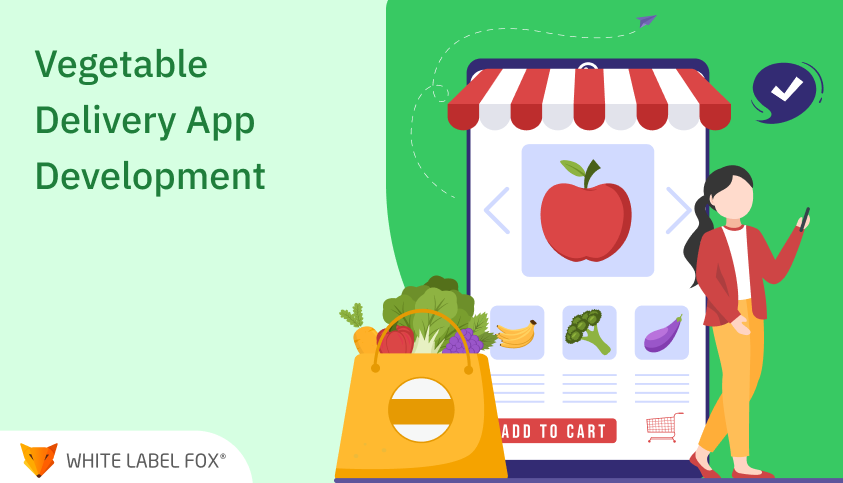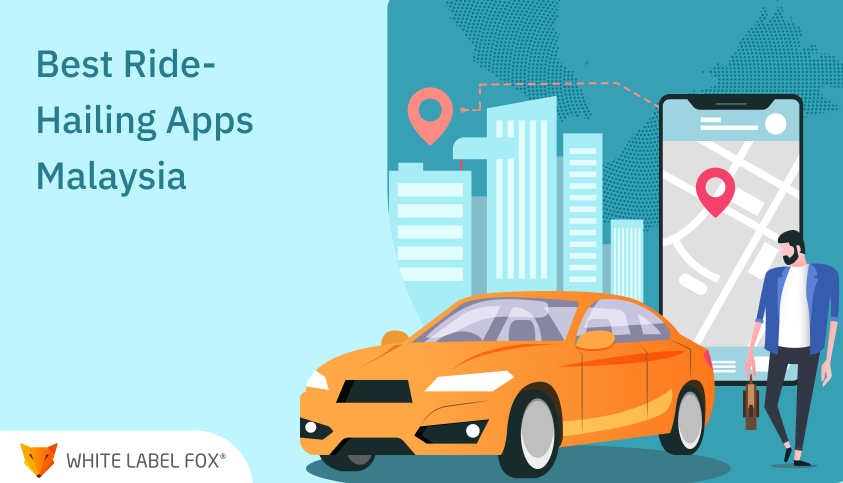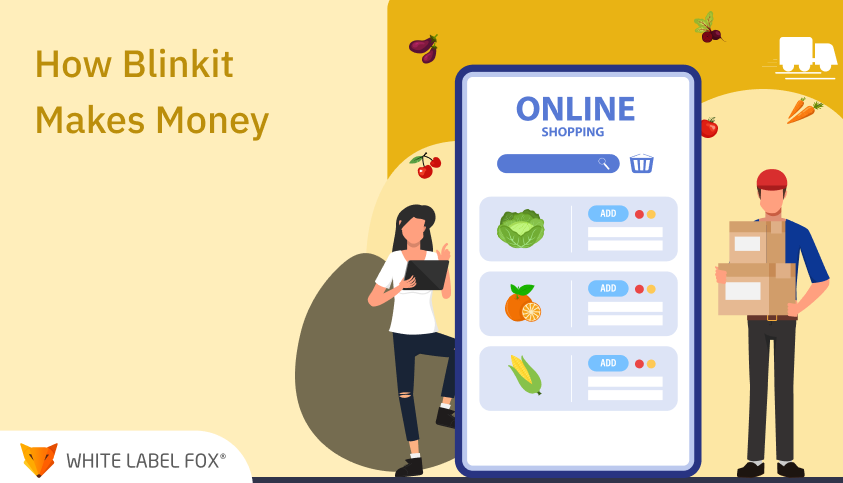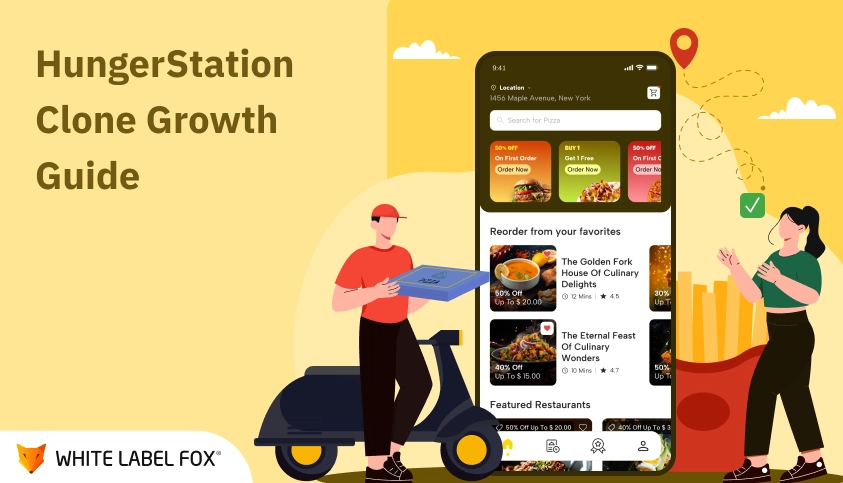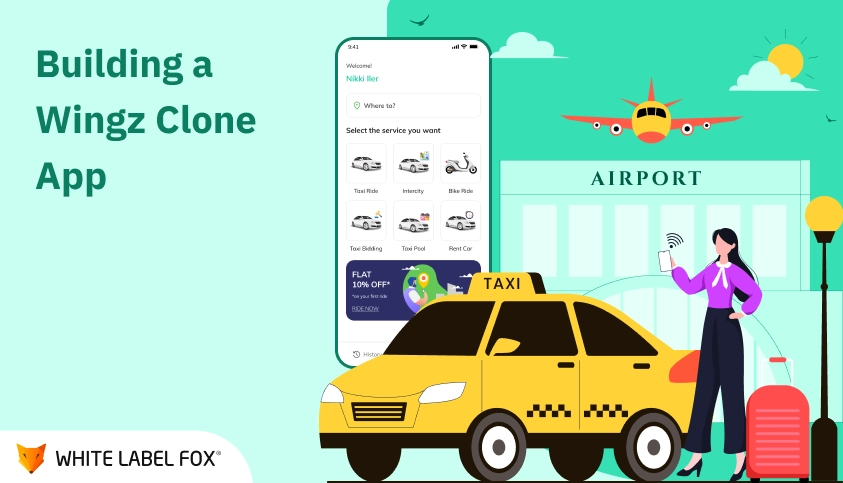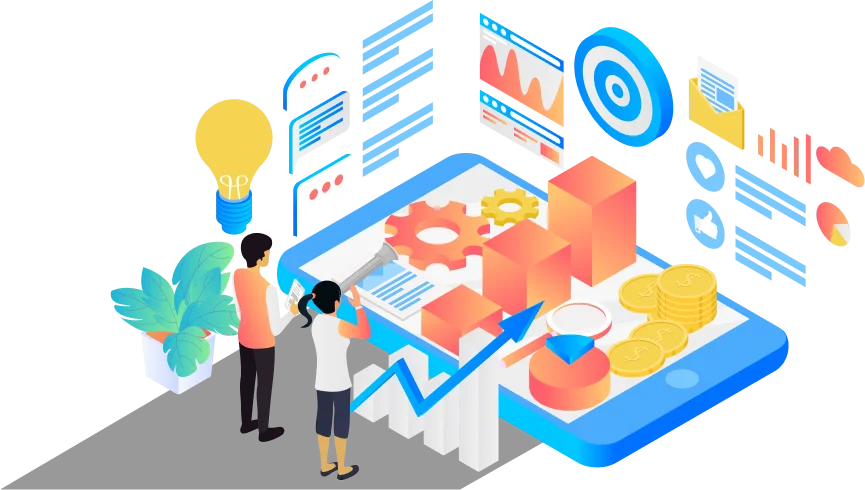Customers are picking online shopping and convenience, and the emerging grocery and vegetable delivery market is gaining popularity as shown in a report by Statista, the online grocery market is expected to be worth $319.77 billion in 2024, reemphasizing that the online shopping sector is rising quickly and offers vast pote ntial.
This phenomenon is accelerated by the COVID-19 pandemic, which has resulted in more and more consumers purchasing online across different business sectors comprising food and fresh goods.
In this blog post, we will look at the new market of vegetable delivery apps, investigate the opportunities and threats entrepreneurs face, and create a plan to help you launch your venture. Developing a vegetable delivery app involves not only market research and identifying the target demographics but also the design of a user-friendly interface and the implementation of robust delivery logistics.
Besides that, we will also touch upon the costing factors and predict how all these factors will affect the investment, both upfront and operational costs, of a vegetable delivery startup in today’s highly competitive scenario. Hence, let’s start this insightful ride into the vegetable delivery app development domain and explore this rapidly growing market.
The online Vegetable and Grocery Delivery Market is Growing By Leaps and Bounds
Over the past few years, the online vegetable and grocery delivery market witnessed unprecedented growth in its rate, which can be attributed to several crucial factors that solicited its speedy escalations.
Industry experts have indicated that the global value of the online grocery market was around 365.74 billion dollars in 2020 and is expected to reach more than 2827.63 billion dollars by 2027.
- Besides that, the fast eCommerce growth is typically caused by the tendency of consumers to be attracted by time-saving options, convenience, and the usage of modern platforms or e-commerce solutions by tech-savvy customers.
- Similarly, the coronavirus pandemic (COVID-19) drove this trend as consumers were led into buying essential goods online, such as fresh produce and groceries, because of the lockdowns and social distancing measures.
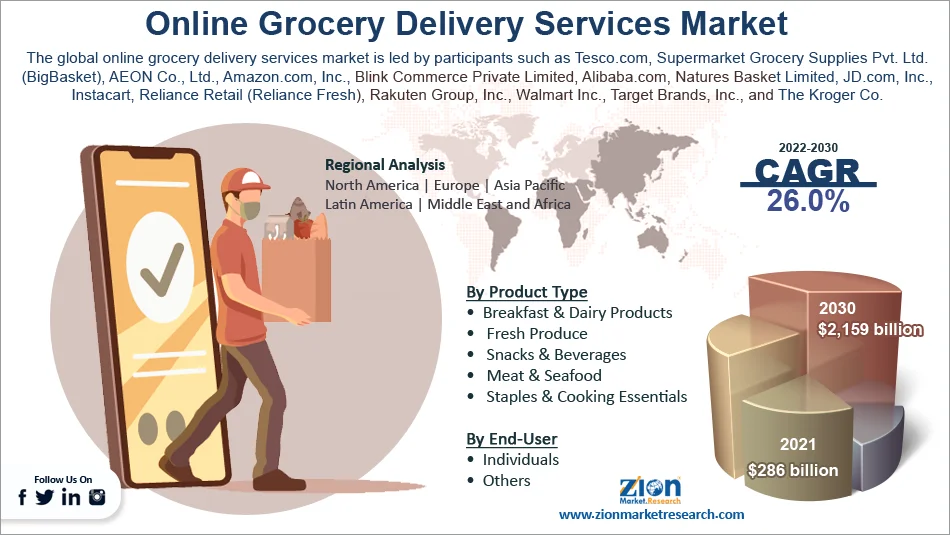
Source:
Zion Market ResearchThe prominent actors in the online vegetable and grocery shipping industry include giant players such as Amazon Fresh, Walmart Grocery, Instacart Fresh Direct, etc. Companies have executed modern technology, logistics, and customer experience to establish a substantial market share and fulfill the growing demand for e-grocery shopping.
In addition to the factors mentioned earlier, contemporary lifestyles, urbanization, increased disposable income, and evolving consumer choices for healthier and organic food options have also accelerated the demand for online delivery of vegetable and dry grocery markets.
Generally, the combination of advancement in technology, shifting customer attitudes, competition from the market, and the constant digital transformation of the retail industry act as the significant determinants of the continued booming of the online delivery of vegetables and groceries and, thus, a memorable opportunity for businesses and entrepreneurs.
Vegetable Delivery App Development: Step-by-Step Guide
Along with the growing online marketplace for vegetables, there are exclusively good chances for entrepreneurs to carve a niche in this profitable sector. In this step-by-step guide, we’ll take you through all the critical stages of vegetable delivery app development, from concept fostering to launch.
Through this development process, It will be quite possible for you to surpass the difficulties in app development and outshine the market competition. Shall we now look at the whole detailed process and see what essential tips we will need to make this app realize itself and, as a result, capture a part of this constantly growing market?
Market Research and Carve Your Niche
Conducting market research is the precondition for developing a vegetable delivery app and is the only answer to understanding the market and identifying your possible niche.
- Begin with the landscape analysis, identifying the main rivals, market events, customer behavior and needs, and difficulties.
- Engage in surveys, interviews, and competitor analysis to determine what users are doing, what they want, and what they do not have from the veggie delivery market.
- This research is very important for explaining the uniqueness of the app that you are creating, identifying the target audience, and putting in place the strategies that will help you differentiate your app from the competitors and which will inadvertently ensure customer loyalty.
Further, searching for the gaps in the market and filling them by having niche segments or specialized offerings will help not only cater to the emerging trends but also identify the market segments that are not accommodated.
Through selecting organic produce, locally sourced vegetables, or custom dietary-oriented options, niche selection is about dealing with these targeted features, products, and marketing approaches, helping to focus on a specific audience. Through robust market research and focusing on the right niche, laying a sturdy economic foundation for a triumphant vegetable delivery app makes it possible to fulfill market demand and surpass customers’ expectations.
Come Out with a New Value Proposition
The value proposition is the basis of differentiation between you and either the pioneers of the business, like Peapod, or the one that dominates the market, like Amazon Fresh. These platforms provide easy use and variety; straight copies of their functionality will not separate your app. Instead of focusing on where your offering stands among your competitors, concentrate on discerning the unique value propositions that best fit your target customers and tackle challenges or unfulfilled market needs.
Evaluate novel features like personalized meal plans corresponding to diets, seasonal or community-produced product collections, or linkages with Community-supported agriculture (CSA) schemes.
Simple sustainability, freshness, and transparency in sourcing might attract environmentally responsible customers. By supplying a competitive advantage from the primary delivery service to various preferences in the vegetable shopping experience, you are likely to create and retain customers looking for a unique and significant experience.
Choose a Business Model
One of the most important initial decisions you should be making is the type of business model that will create the base on which your vegetable delivery app will be built. Several models are already distinctive for each model, covering uniqueness and benefits. Let’s explore three main types: Multi-vendor, Inventory-based, and Hyperlocal.
Multi-vendor Model
This model depends on working with a wide range of vendors or direct purchases from farmers to provide their products and vegetables of various assortments. The availability of a range of options will give the customers a chance to decide from plenty suitable for the competition and variety.
Inventory-based Model
With this model, you maintain a local supply of vegetables sourced directly from farms and wholesalers. This gives more power to the manufacturer in terms of quality, price, and product availability. However, businesses must invest in storing and managing inventories to maintain regular customer supply and quality.
Hyperlocal Model
The hyperlocal model emphasized the community it was located- small areas or neighborhoods that maintained direct deliveries and personalized services. Through working with local partners and improving the delivery logistics, you can deliver more goods in less time and be more in tune with the particular wishes of your essential customers. The hyperlocal market is one thing, but a strategic expansion plan would be critical.
Each business model has its pros and cons. Thus, conducting a thorough assessment considering resource availability, target audience, and desired future strategy is essential to establish the approach that best suits the vegetable delivery app.
Development Stage
In the vegetable delivery app’s development stage, essential features will be decided to define the user experience and functionality.
Features such as a user-friendly navigation system for vegetables, advanced searching offers, a secured payment gateway, real-time ordering and delivery tracking system, and customer support channels should be considered.
Partnering up with a trusted grocery delivery app development company will allow you to run your project smoothly, using their expertise and technical know-how to deploy such an app effectively.
When you don’t know the features you need or want to look for in the market before you build a product, choosing the Minimal Viable Product (MVP) approach might be more helpful. The MVP, a simplified app version containing the fundamental features, helps you collect user feedback, validate assumptions, and work on real-time data while maintaining room for improvements.
This repetitive approach initially decreases the development costs and guarantees that your vegetable delivery app matches the customer’s needs and promotional trends, making it more likely to succeed.
Work On Revenue Streams
The last step in developing your vegetable delivery application is to start building different ways to make money so that it can sustain and create profits for you. Explore multiple monetization avenues such as:
Delivery Fees
Let the customers pay a small fee to deliver the vegetables to their doorstep. You’ve got two options; for example, you can offer free delivery for orders that exceed a determined value to attract higher purchases.
Subscription Models
Market subscription plans with benefits like cut-down prices, priority delivery slots, and special offers for customers who choose to come back repeatedly. This establishes a sustained revenue stream and keeps the customers returning.
Commission from Vendors
You should also consider the kind of business model you will adopt: if you choose a multi-vendor model, you can set a commission rate for vendors who list their products on your platform and make sales through your app.
Advertising and Partnerships
Involve the local businesses, restaurants, and vegetable suppliers in your promotional partnerships and sponsored listings. The app may also place targeted ads to attract more money.
One way to achieve long-term app viability is to have a diverse revenue stream, and it should also align with the value proposition of the app and its user base. This will guarantee that the app generates constant income and achieves its objective.
Invest in Vegetable Delivery App to Get Promising Returns
The idea of a vegetable delivery application could be the starting point for taking advantage of the increasing demand for grocery delivery. With the market demonstrating solid growth and increasing consumer demand for ease of use, it would make sense to join in and ditch the rest of the big boys for what you can offer.
Your app will lead the pack by tapping into technological advancements and new solutions. It will be recognized for its pioneering role in the dynamic world of online grocery and vegetable ordering.
Frequently Ask Questions
A vegetable delivery app is a mobile platform that allows users to order
fresh vegetables from local vendors or farms and have them delivered to
their doorstep. These apps provide a convenient solution for customers
to access high-quality, organic, and seasonal produce without having to
visit a physical market.
Key features of a vegetable delivery app include:
- User Registration: Customers can create profiles and
securely store their preferences.
- Product Listings: Displays a range of fresh vegetables,
categorized by type, season, or farm.
- Search & Filters: Users can search for specific
vegetables and filter products by type, price, or freshness.
- Real-Time Order Tracking: Allows users to track their
delivery in real-time.
- Secure Payment Options: Offers multiple payment methods
like credit/debit cards, mobile wallets, or cash on delivery.
- Subscription Plans: Customers can subscribe for regular
deliveries to ensure they get fresh vegetables weekly or
monthly.
- Ratings & Reviews: Customers can rate vegetables and
vendors based on quality and service.
- Notifications: For order status, delivery updates, and
promotional offers.
- User Registration: Customers can create profiles and securely store their preferences.
- Product Listings: Displays a range of fresh vegetables, categorized by type, season, or farm.
- Search & Filters: Users can search for specific vegetables and filter products by type, price, or freshness.
- Real-Time Order Tracking: Allows users to track their delivery in real-time.
- Secure Payment Options: Offers multiple payment methods like credit/debit cards, mobile wallets, or cash on delivery.
- Subscription Plans: Customers can subscribe for regular deliveries to ensure they get fresh vegetables weekly or monthly.
- Ratings & Reviews: Customers can rate vegetables and vendors based on quality and service.
- Notifications: For order status, delivery updates, and promotional offers.
The steps to develop a vegetable delivery app are as follows:
- Market Research: Understand the target market,
competition, and customer preferences to refine your app’s
concept.
- Define Features: Identify essential features, including
product listings, search filters, payment systems, and delivery
tracking.
- Select Technology Stack: Choose the right technology for
developing the app (Flutter, React Native, etc.) based on
platform preferences and budget.
- UI/UX Design: Design an intuitive and user-friendly
interface to enhance the user experience.
- Development: Develop the app’s backend (for managing
data) and frontend (the app itself).
- Testing: Perform thorough testing to ensure that the app
functions smoothly, with no bugs or performance issues.
- Launch: Publish the app on the Apple App Store, Google
Play Store, or other relevant platforms.
- Post-Launch Maintenance: Regularly update the app to fix
bugs, add new features, and improve security.
- Market Research: Understand the target market, competition, and customer preferences to refine your app’s concept.
- Define Features: Identify essential features, including product listings, search filters, payment systems, and delivery tracking.
- Select Technology Stack: Choose the right technology for developing the app (Flutter, React Native, etc.) based on platform preferences and budget.
- UI/UX Design: Design an intuitive and user-friendly interface to enhance the user experience.
- Development: Develop the app’s backend (for managing data) and frontend (the app itself).
- Testing: Perform thorough testing to ensure that the app functions smoothly, with no bugs or performance issues.
- Launch: Publish the app on the Apple App Store, Google Play Store, or other relevant platforms.
- Post-Launch Maintenance: Regularly update the app to fix bugs, add new features, and improve security.
The cost of developing a vegetable delivery app can vary based on
several factors, including:
- Platform: Developing for both iOS and Android will be
more expensive than developing for just one platform.
- Features: The more advanced features (e.g., real-time
tracking, subscription plans, etc.), the higher the cost.
- Design: A custom-designed interface may increase costs
compared to a template-based design.
- Development Team Location: Development costs depend on
the geographical location of the development team. For example,
developers in North America or Europe may charge higher rates
compared to those in Asia.
- Backend Infrastructure: A robust backend for order
management, product listings, and real-time tracking can
increase costs.
Estimated Cost: The development of a basic vegetable delivery app
could cost around $15,000 to $35,000. A more complex app with
advanced features might cost between $35,000 to $70,000 or more.
- Platform: Developing for both iOS and Android will be more expensive than developing for just one platform.
- Features: The more advanced features (e.g., real-time tracking, subscription plans, etc.), the higher the cost.
- Design: A custom-designed interface may increase costs compared to a template-based design.
- Development Team Location: Development costs depend on the geographical location of the development team. For example, developers in North America or Europe may charge higher rates compared to those in Asia.
- Backend Infrastructure: A robust backend for order management, product listings, and real-time tracking can increase costs.
Vegetable delivery apps can adopt various monetization strategies,
including:
- Delivery Charges: Charging customers a fixed delivery fee
for each order.
- Subscription Plans: Offering subscription-based services
for regular deliveries at discounted rates.
- Product Markup: Adding a small markup on the cost of
vegetables to earn a profit.
- Vendor Commission: Charging a commission to local vendors
or farms for listing their products on the app.
- Advertising: Displaying advertisements from local
businesses, farm products, or related services within the app.
- Premium Features: Offering premium features such as
express delivery or priority service for a higher fee.
- Delivery Charges: Charging customers a fixed delivery fee for each order.
- Subscription Plans: Offering subscription-based services for regular deliveries at discounted rates.
- Product Markup: Adding a small markup on the cost of vegetables to earn a profit.
- Vendor Commission: Charging a commission to local vendors or farms for listing their products on the app.
- Advertising: Displaying advertisements from local businesses, farm products, or related services within the app.
- Premium Features: Offering premium features such as express delivery or priority service for a higher fee.
Some common challenges include:
- Supply Chain Management: Ensuring the availability and
timely delivery of fresh vegetables can be a challenge,
especially during peak seasons or high demand.
- Quality Control: Maintaining consistent product quality,
particularly when dealing with perishable goods, requires robust
quality checks.
- Competition: The market for vegetable delivery apps is
highly competitive, with established players already dominating
the market in many regions.
- Logistics: Managing a delivery network for fresh produce
requires efficient routing, inventory management, and
partnerships with vendors.
- Customer Retention: Retaining customers in the long term
requires offering consistent quality, reliable service, and
competitive prices.
- Supply Chain Management: Ensuring the availability and timely delivery of fresh vegetables can be a challenge, especially during peak seasons or high demand.
- Quality Control: Maintaining consistent product quality, particularly when dealing with perishable goods, requires robust quality checks.
- Competition: The market for vegetable delivery apps is highly competitive, with established players already dominating the market in many regions.
- Logistics: Managing a delivery network for fresh produce requires efficient routing, inventory management, and partnerships with vendors.
- Customer Retention: Retaining customers in the long term requires offering consistent quality, reliable service, and competitive prices.
Effective marketing strategies for a vegetable delivery app include:
- SEO & Content Marketing: Optimize your app's website and
content to appear in relevant search queries and attract organic
traffic.
- Referral Programs: Reward customers for referring others
to the app with discounts or freebies.
- Social Media: Leverage platforms like Instagram,
Facebook, and Pinterest to build a community and engage
customers.
- Influencer Marketing: Partner with food bloggers or
influencers to promote the app to a wider audience.
- Discount Offers: Offer seasonal discounts or promotional
offers to attract new users and increase app downloads.
- Local Partnerships: Collaborate with local farms or
grocery stores to increase product variety and offer exclusive
deals.
- SEO & Content Marketing: Optimize your app's website and content to appear in relevant search queries and attract organic traffic.
- Referral Programs: Reward customers for referring others to the app with discounts or freebies.
- Social Media: Leverage platforms like Instagram, Facebook, and Pinterest to build a community and engage customers.
- Influencer Marketing: Partner with food bloggers or influencers to promote the app to a wider audience.
- Discount Offers: Offer seasonal discounts or promotional offers to attract new users and increase app downloads.
- Local Partnerships: Collaborate with local farms or grocery stores to increase product variety and offer exclusive deals.
Key trends to watch in the vegetable delivery app market include:
- Sustainability: Increased demand for eco-friendly
packaging, organic produce, and sustainable farming practices.
- Subscription Models: Growing preference for subscription
services that ensure regular deliveries at discounted rates.
- AI & Personalization: Use of artificial intelligence to
offer personalized recommendations based on user preferences and
purchase history.
- Local Sourcing: Partnering with local farmers to offer
fresher and more sustainable produce.
- Same-Day Delivery: A rising demand for faster delivery
times, including same-day or express delivery options.
- Sustainability: Increased demand for eco-friendly packaging, organic produce, and sustainable farming practices.
- Subscription Models: Growing preference for subscription services that ensure regular deliveries at discounted rates.
- AI & Personalization: Use of artificial intelligence to offer personalized recommendations based on user preferences and purchase history.
- Local Sourcing: Partnering with local farmers to offer fresher and more sustainable produce.
- Same-Day Delivery: A rising demand for faster delivery times, including same-day or express delivery options.
To ensure the success of a vegetable delivery app:
- Offer Fresh, High-Quality Products: Partner with trusted
local vendors or farms to provide fresh and high-quality
vegetables.
- Provide Excellent Customer Service: Ensure timely
deliveries, easy returns, and responsive customer support.
- Optimize the User Experience: Keep the app intuitive and
easy to navigate, offering a seamless shopping experience.
- Competitive Pricing: Offer competitive pricing and
attractive discounts to appeal to cost-conscious customers.
- Leverage Data & Analytics: Use data analytics to
understand customer behavior, improve marketing efforts, and
enhance the app experience.
- Offer Fresh, High-Quality Products: Partner with trusted local vendors or farms to provide fresh and high-quality vegetables.
- Provide Excellent Customer Service: Ensure timely deliveries, easy returns, and responsive customer support.
- Optimize the User Experience: Keep the app intuitive and easy to navigate, offering a seamless shopping experience.
- Competitive Pricing: Offer competitive pricing and attractive discounts to appeal to cost-conscious customers.
- Leverage Data & Analytics: Use data analytics to understand customer behavior, improve marketing efforts, and enhance the app experience.

